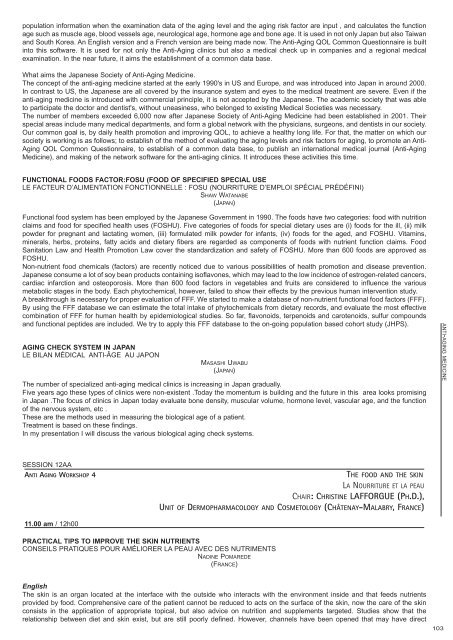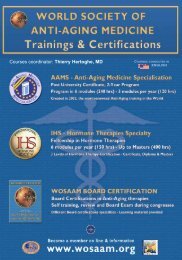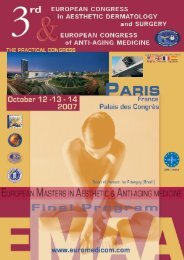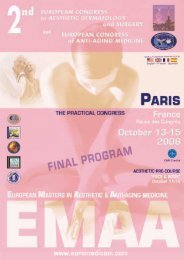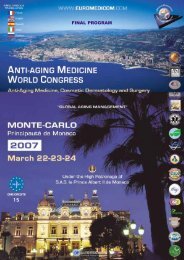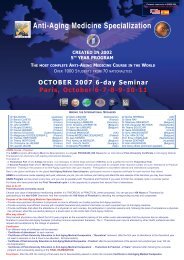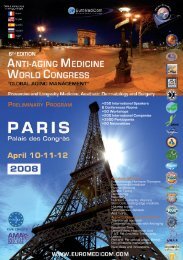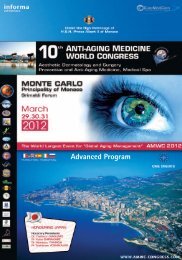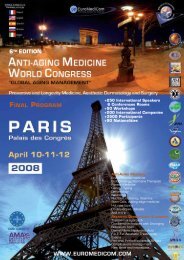FINAL PROGRAM 6TH EDITION - EuroMediCom
FINAL PROGRAM 6TH EDITION - EuroMediCom
FINAL PROGRAM 6TH EDITION - EuroMediCom
You also want an ePaper? Increase the reach of your titles
YUMPU automatically turns print PDFs into web optimized ePapers that Google loves.
population information when the examination data of the aging level and the aging risk factor are input , and calculates the functionage such as muscle age, blood vessels age, neurological age, hormone age and bone age. It is used in not only Japan but also Taiwanand South Korea. An English version and a French version are being made now. The Anti-Aging QOL Common Questionnaire is builtinto this software. It is used for not only the Anti-Aging clinics but also a medical check up in companies and a regional medicalexamination. In the near future, it aims the establishment of a common data base.What aims the Japanese Society of Anti-Aging Medicine.The concept of the anti-aging medicine started at the early 1990's in US and Europe, and was introduced into Japan in around 2000.In contrast to US, the Japanese are all covered by the insurance system and eyes to the medical treatment are severe. Even if theanti-aging medicine is introduced with commercial principle, it is not accepted by the Japanese. The academic society that was ableto participate the doctor and dentist's, without uneasiness, who belonged to existing Medical Societies was necessary.The number of members exceeded 6,000 now after Japanese Society of Anti-Aging Medicine had been established in 2001. Theirspecial areas include many medical departments, and form a global network with the physicians, surgeons, and dentists in our society.Our common goal is, by daily health promotion and improving QOL, to achieve a healthy long life. For that, the matter on which oursociety is working is as follows; to establish of the method of evaluating the aging levels and risk factors for aging, to promote an Anti-Aging QOL Common Questionnaire, to establish of a common data base, to publish an international medical journal (Anti-AgingMedicine), and making of the network software for the anti-aging clinics. It introduces these activities this time.FUNCTIONAL FOODS FACTOR:FOSU (FOOD OF SPECIFIED SPECIAL USELE FACTEUR D’ALIMENTATION FONCTIONNELLE : FOSU (NOURRITURE D’EMPLOI SPÉCIAL PRÉDÉFINI)SHAW WATANABE(JAPAN)Functional food system has been employed by the Japanese Government in 1990. The foods have two categories: food with nutritionclaims and food for specified health uses (FOSHU). Five categories of foods for special dietary uses are (i) foods for the ill, (ii) milkpowder for pregnant and lactating women, (iii) formulated milk powder for infants, (iv) foods for the aged, and FOSHU. Vitamins,minerals, herbs, proteins, fatty acids and dietary fibers are regarded as components of foods with nutrient function claims. FoodSanitation Law and Health Promotion Law cover the standardization and safety of FOSHU. More than 600 foods are approved asFOSHU.Non-nutrient food chemicals (factors) are recently noticed due to various possibilities of health promotion and disease prevention.Japanese consume a lot of soy bean products containing isoflavones, which may lead to the low incidence of estrogen-related cancers,cardiac infarction and osteoporosis. More than 600 food factors in vegetables and fruits are considered to influence the variousmetabolic stages in the body. Each phytochemical, however, failed to show their effects by the previous human intervention study.A breakthrough is necessary for proper evaluation of FFF. We started to make a database of non-nutrient functional food factors (FFF).By using the FFF database we can estimate the total intake of phytochemicals from dietary records, and evaluate the most effectivecombination of FFF for human health by epidemiological studies. So far, flavonoids, terpenoids and carotenoids, sulfur compoundsand functional peptides are included. We try to apply this FFF database to the on-going population based cohort study (JHPS).AGING CHECK SYSTEM IN JAPANLE BILAN MÉDICAL ANTI-ÂGE AU JAPONMASASHI UWABU(JAPAN)The number of specialized anti-aging medical clinics is increasing in Japan gradually.Five years ago these types of clinics were non-existent .Today the momentum is building and the future in this area looks promisingin Japan .The focus of clinics in Japan today evaluate bone density, muscular volume, hormone level, vascular age, and the functionof the nervous system, etc .These are the methods used in measuring the biological age of a patient.Treatment is based on these findings.In my presentation I will discuss the various biological aging check systems.ANTI-AGING MEDICINESESSION 12AAANTI AGING WORKSHOP 4THE FOOD AND THE SKINLA NOURRITURE ET LA PEAUCHAIR: CHRISTINE LAFFORGUE (PH.D.),UNIT OF DERMOPHARMACOLOGY AND COSMETOLOGY (CHÂTENAY-MALABRY, FRANCE)11.00 am / 12h00PRACTICAL TIPS TO IMPROVE THE SKIN NUTRIENTSCONSEILS PRATIQUES POUR AMÉLIORER LA PEAU AVEC DES NUTRIMENTSNADINE POMAREDE(FRANCE)EnglishThe skin is an organ located at the interface with the outside who interacts with the environment inside and that feeds nutrientsprovided by food. Comprehensive care of the patient cannot be reduced to acts on the surface of the skin, now the care of the skinconsists in the application of appropriate topical, but also advice on nutrition and supplements targeted. Studies show that therelationship between diet and skin exist, but are still poorly defined. However, channels have been opened that may have direct103


